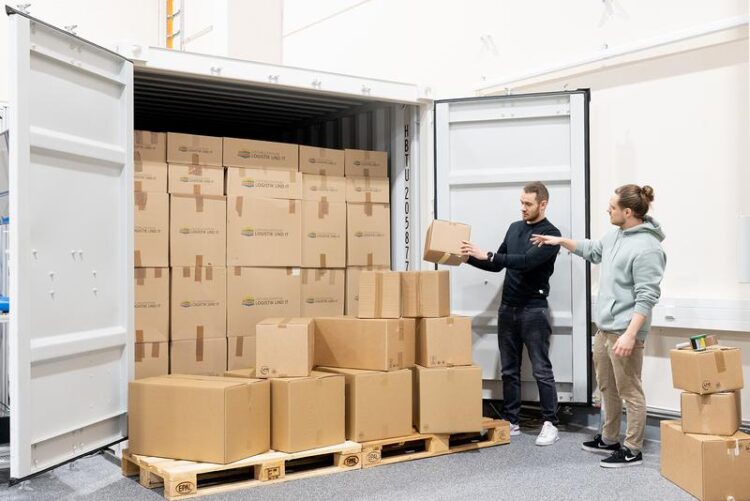Optimal shipping carton utilization

With the help of the CASTN optimization software, shipping companies can select the optimal carton set for each item and order structure.
© Fraunhofer IML
Products ordered online are often shipped in oversized cartons. The size of the overall package is frequently much larger than its contents. For example, a fragrance bottle is shipped in a shoebox-sized package, which has padding to fill the empty space. This is not sustainable. Helping to combat this issue is the CASTN optimization software created by the Fraunhofer Institute for Material Flow and Logistics IML, which puts together the optimum order-to-carton combination for each customer’s order. Clever algorithms calculate the best carton utilization based on the item and order structure.
Online retail is constantly changing — the latest trends and seasonal fluctuations influence the structure of items and orders. With increasing product diversity and a variable order structure, the range of shipping cartons is also growing over time. Although the types of packaging available are becoming increasingly diverse, in many cases the degree of volume utilization is falling. Items that require little packaging, such as fragrances, cosmetics and jewelry, end up in oversized cartons. This is largely because packaging is not selected based on changing product and order requirements, such as dimensions and weight. Researchers at Fraunhofer IML are addressing this issue with the CASTN (Carton Set Optimization) software, which was funded by the Fraunhofer Center of Excellence Logistics and IT.
CASTN puts together the optimal carton set for the individual item and order structure for shipping companies. “If a retailer wants to use a set of ten different cartons at their packing stations, they need to be adapted to the order and item structure in order to achieve the best possible volume utilization. The products need to fill as much of the carton’s volume as possible so that as little padding (e.g., bubble wrap) as possible is needed,” explains Lukas Lehmann, scientist at Fraunhofer IML. In order to achieve this, the development team at Fraunhofer IML is inputting customer data (order, item master and packing specification data) into CASTN. To portray a representative time period including seasonal fluctuations, the data generally stretches over a full year. Using these input parameters, two interlinked software algorithms work together to calculate the optimum carton set. These take customer requirements, such as minimum or maximum package sizes, as well as the needs of the logistics service provider into account.
30% item, 70% air
CASTN functions using two algorithms: The first uses an evolutionary approach to create different carton sets on the basis of parameters such as the number of permitted cartons or the maximum and minimum dimensions. The second — a bin-packing algorithm — ensures that the orders are efficiently packed in the selected cartons. The aim of this is to minimize packaging volume and achieve the smallest possible overall volume. At the end of this process, the software assesses each carton in a set, checking how well the internal capacity is filled by the order inside. This information is fed back into the evolutionary algorithm, which uses each carton’s score to create new, better sets. This continues until no better volume utilization can be achieved. “Customers are often unaware of the volume utilization of their packaging, which is frequently only around 30%. They have no idea how much air they send. This is what our software calculates,” says the researcher. Once optimization is complete, the results are analyzed together with the customer so that they can select the appropriate carton set.
Several industry partners, each with their own online retail business, have already benefited from carton set optimization and increased their volume utilization by 35 to 45% while also reducing the number of carton types used.
Making e-commerce more eco-conscious
In the next stage, Lehmann and his team want to expand the functionality of the software to include complex item shapes and additional item characteristics. “We want CASTN to increase sustainability in logistics. Packaging and padding material can be reduced using optimally coordinated carton sets. This will result in better truck loading as well as reduced CO2 emissions and can also avoid wasted space,” says Lehmann. By using CASTN, companies shipping products can make a difference to the planet while saving on packaging and transit costs.
Weitere Informationen:
https://www.fraunhofer.de/en/press/research-news/2024/march-2024/optimal-shippin…
Media Contact
All latest news from the category: Transportation and Logistics
This field deals with all spatial and time-related activities involved in bridging the gap between goods and people, including their restructuring. This begins with the supplier and follows each stage of the operational value chain to product delivery and concludes with product disposal and recycling.
innovations-report provides informative reports and articles on such topics as traffic telematics, toll collection, traffic management systems, route planning, high-speed rail (Transrapid), traffic infrastructures, air safety, transport technologies, transport logistics, production logistics and mobility.
Newest articles

Innovative 3D printed scaffolds offer new hope for bone healing
Researchers at the Institute for Bioengineering of Catalonia have developed novel 3D printed PLA-CaP scaffolds that promote blood vessel formation, ensuring better healing and regeneration of bone tissue. Bone is…

The surprising role of gut infection in Alzheimer’s disease
ASU- and Banner Alzheimer’s Institute-led study implicates link between a common virus and the disease, which travels from the gut to the brain and may be a target for antiviral…

Molecular gardening: New enzymes discovered for protein modification pruning
How deubiquitinases USP53 and USP54 cleave long polyubiquitin chains and how the former is linked to liver disease in children. Deubiquitinases (DUBs) are enzymes used by cells to trim protein…



